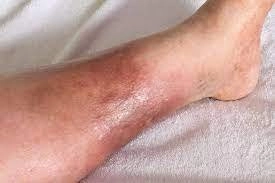Cellulitis What You Need to Know
1/13
Cellulite looks a lot like cellulite, but the two conditions have nothing in common. Cellulite is a dimple on the skin caused by fatty deposits. Cellulitis is a painful skin infection that occurs when bacteria invade the skin. Call your doctor as soon as possible if you have a red, swollen, tender rash, as it can be life-threatening if left untreated.
Beware of these symptoms
2/13
Cellulite most commonly affects the lower legs, but it can also occur on other parts of the body.Common spots are the arms, around the eyes, chest, and abdomen. Not everyone will have the same symptoms, but these are typical.
• dull or tender pain
• swelling
warmth
• Fever and chills
• swollen glands and lymph nodes
• A painful rash that forms blisters and scabs
blame your own bacteria
3/13
Staphylococcus aureus (streptococcus) and Staphylococcus aureus (staphylococcus) are types of bacteria that usually cause cellulitis. They usually live on the skin, nose, and mouth, and are harmless. However, once a cut is made, even if it is a small cut that you don't see, they can invade your body and multiply, causing infection and swelling. can cause it.
easy to diagnose
13.4
Your doctor should be able to tell if you have cellulite just by looking at your skin.Most cases are mild and do not require testing. But your doctor may order laboratory tests to better understand what's going on under your skin.This is usually done for people with severe cases or underlying medical conditions.
Laboratory test for cellulite
5/13
If your case seems mild and treatable, your doctor won't order a lab test. Laboratory tests are important for people who:
• Severe skin infections
• Fever or other signs of spreading infection
• Poor response to initial antibiotic treatment
• Underlying diseases such as cancer or diabetes
• Was recently bitten by an animal
Do you need an MRI?
6/13
Magnetic Resonance Imaging (MRI) is another test doctors use if you have symptoms of cellulite. It helps distinguish between cellulitis and bone infections called osteomyelitis. Get one if you have:
• Immune system problems
• Diabetes mellitus
• Poor blood circulation in the lower extremities
Lymphoedema (chronic swelling)
Beware of misdiagnosis
7/13
Make sure the diagnosis is made by an experienced doctor. Cellulitis can look like several other skin diseases and conditions that require different treatments, including:
Congestive dermatitis:
swelling associated with poor circulation, usually in the lower extremities
• Contact dermatitis:
a rash caused by something touching the skin
panniculitis:
Inflammation of subcutaneous fat
process:
Antibiotics
8/13
Cellulitis requires treatment with antibiotics. What you get depends on how serious your condition is:
heavy:
Antibiotics are given into a vein in your arm (doctors call this intravenous).
light:
Your doctor will give you an oral antibiotic such as cephalexin or dicloxacillin.
Take oral antibiotics as soon as your doctor prescribes them, and stop the medication as directed. Remember that cellulite can be dangerous if not properly treated.
process:
home care
9/13
Antibiotics are the main treatment for this condition, but there are things you can do at home. If the infection is in an arm or leg, support the limb above the level of the heart. This will reduce swelling and help you heal faster. Also, the infected area should be kept clean and dry. It's okay to take a shower. Pat the affected area dry. Do not rub. Also, do not use antibiotic ointments or creams.
you should feel better soon
10/13
Mild cases get immediate medical attention and you'll be out of the woods in no time. Expect your fever and chills (if any) to abate within a day or two of starting the medication. please. Swelling and fever may improve within a few days, but these symptoms may persist for weeks. If antibiotics don't make you feel better within a few days, see your doctor. Other drugs and possibly more tests may be needed.
Is cellulite contagious?
11/13
It is not highly contagious. You don't have to keep your distance from others or wipe down every surface you touch. However, wash your hands frequently with soap and water. Also, do not share personal items such as towels.
Risk factor
12/13
You are more likely to develop cellulite if:
• You have conditions that can cause small tears in the skin, such as: B. Eczema, athlete's foot or shingles.
• Living with diabetes or a weakened immune system
• Chronic swelling of the arms or legs (lymphoedema)
• Inject drugs
possible complications
13/13
Early treatment increases the chances of a full recovery without complications. However, if you wait too long, the cellulite infection will cease to be superficial. Bacteria can enter the blood in a condition known as bacteremia. And from there, you are more likely to get sick. So, at the first signs of cellulite, it's safe to call or see your doctor.
31 Dec 2022







